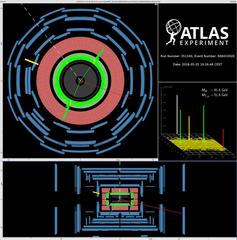An example event display from the ATLAS detector showing the generation of signatures revealing the presence of W and Z bosons as well as a photon. These events were made more visible through new advances in the analysis of the data from the Large Hadron Collider (LHC)'s Run 2 as well as a new and more precise value of the LHC luminosity. (Image: ATLAS Collaboration)
DESY scientists working with data from the Large Hadron Collider (LHC) at CERN in Geneva have uncovered a rare, previously unseen process where three important carrier particles are produced at once. Using a dataset from the last completed data collection session, called Run 2, the team revealed strongly statistically significant evidence of a process that further describes the relationship between two of the four fundamental forces of the universe: the weak force and electromagnetism. This process involves the simultaneous production of the two carrier particles of the weak force, the W and Z bosons, alongside the photon, the carrier particle of the electromagnetic force.
The electromagnetic and weak forces have been long seen to have a close relationship. Since the first description of the Theory of General Relativity, theorists have worked backwards to try to figure out how the four fundamental forces – electromagnetism, the weak force, the strong force, and gravitation – initially comprised a single theorised interaction emerging from the Big Bang. In this effort, theorists have calculated that the electromagnetic and weak forces were the most recent to separate from one another, with many experimental results edifying these calculations. To see the particles that carry these forces, the bosons, emerging from a single collision at a facility such as the LHC and interacting with one another along their paths moving away from the collision is one such observation. The two bosons of the weak force, the electrically charged W and the electrically neutral Z, have been individually seen with the photon, but until now not all three had been spotted together emerging from a single collision.
DESY Particle Physics Director Beate Heinemann, who is an ATLAS scientist and professor at the University of Freiburg, had proposed using the huge amount of information from Run 2 to find evidence of all three bosons being produced at once. “By using the full dataset from Run 2, you can find rare processes,” says Ludociva Aperio Bella, a DESY ATLAS scientist who was tasked by Heinemann to lead the analysis.
“I am excited that we observed for the first time the simultaneous production of all three electroweak gauge bosons,” Heinemann says. “This is a very rare process and thus was only possible now, nearly 15 years after the LHC started. Understanding how these bosons interact is at the heart of understanding our early universe.”
Part of the challenge of the result was to locate the signatures of the W and Z bosons and the photon they were grouped with, a reading that is not exceptionally distinct from many other traces of particles careening out of the collision site. These other traces are referred to as “background,” and the analysis team needed to find ways to make the background as limited as possible so they could identify the signal they were looking for more easily. This was accomplished using newly derived statistical methods. “With more complex techniques than we’ve ever had before, we can see three-boson production,” Bella says.
But also critical to the team’s success was a newly updated value of the LHC’s luminosity. The luminosity is a figure describing the average number of protons in each collision, which, when revised more accurately, increases the precision of all measurements. The new luminosity value was calculated last year with heavy DESY involvement, and it gave an added push to isolating the signatures of the W and Z bosons and their partnered photon that the team was looking for in the Run 2 data.
These efforts yielded enough distinct observations of the three bosons together to reveal an observation with a high statistical significance. The results were calculated at a significance of 6.3 sigma, where 5 sigma is the threshold for a verified observation. This means the three-boson observation can be stated to be 99.99966% certain – about a 3 in a million chance that the phenomenon was seen in error. On top of that, the team could measure details about the collision from the result, helping show how the three bosons could be generated at once as well as the interaction between the three particles as they travelled away from the collision point.
“This is really a critical result for closing up the Standard Model,” Bella says, referencing the theory that describes the relationship between three of the four fundamental forces in physics. “It’s important to finding physics beyond the Standard Model, because whenever we observe a rare process like this, we force our theory colleagues to put it into context. That context helps make future results much more precise, so that we know what to look for. Knowing how multi-boson production occurs helps us better control the picture.”
The analysis was led by scientists from DESY and involves scientists from the University of Freiburg.








